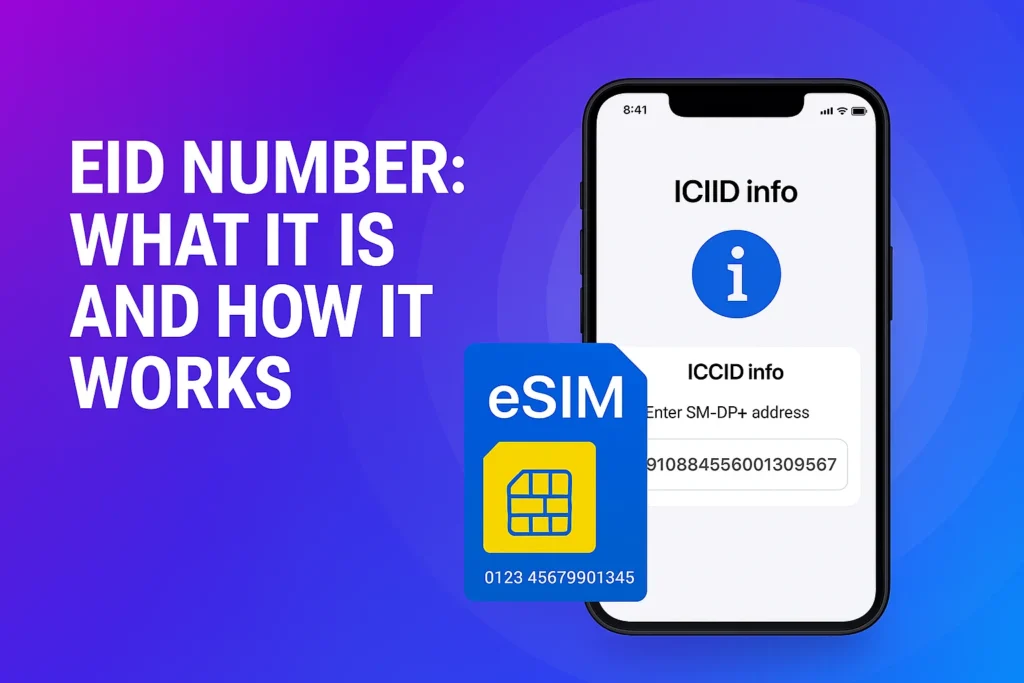EID Number: What It Is and How It Works
Embedded Identity Documents (EIDs) are transforming the world of mobile communication by enabling a smoother, more flexible way to connect. Essentially, an EID is a unique identification number built directly into devices that support eSIM technology.
In this guide, we’ll break down what an EID number is, how it works, how you can find it on your phone, and which devices come equipped with this innovative feature. Whether you’re curious about upgrading to an eSIM-compatible device or simply want to understand how EIDs power digital connectivity, this article covers everything you need to know.
What does EID number mean on an eSIM device?
An EID number (Embedded Identity Document number) is a unique 32-digit identifier built into every device that supports eSIM technology. It serves as the digital fingerprint of the eSIM chip inside your phone, tablet, or smartwatch.
Even if you haven’t activated an eSIM yet, the EID number still identifies your device’s embedded SIM hardware — allowing mobile carriers to recognize and manage it for future eSIM activations or transfers.
What is the purpose of an EID number?
Mobile providers rely on the EID number to activate and manage eSIM profiles on your phone or other compatible devices.
Unlike traditional SIM cards, eSIMs are built directly into your device and can be activated digitally — usually by scanning a QR code or through a mobile app. This eliminates the need to insert or replace physical SIM cards when switching carriers or traveling abroad.
Every eSIM-enabled device includes an EID number that connects the device to virtual SIM profiles. You can store multiple eSIM profiles on the same device, though they all share the same EID number. This system makes managing mobile plans easier, faster, and more flexible.
How to find your EID number on iPhone or Android
You can locate your phone’s EID number in two main ways:
- Check the original box: The EID is often printed on the packaging or listed in the user manual.
- Look in your phone settings: The exact steps depend on your phone brand and operating system.
On iPhone
If you own an iPhone, you can usually find the EID number printed on the back of the phone’s box, along with the serial number and IMEI. To verify it directly on your device:
- Open Settings.
- Tap General.
- Select About.
- Scroll down to the Digital SIM section — your EID will be displayed there.
On Android (Samsung and others)
Many Android devices, especially Samsung phones, also list the EID number on the original box. If you prefer to find it through your device settings:
- Open Settings.
- Go to About Phone or About Device.
- Tap Status, Status Information, or SIM Card Status.
- Your EID will appear in the eSIM or SIM-related section.
On Google Pixel
To find the EID number on a Google Pixel phone:
- Open Settings.
- Scroll down and tap About Phone.
- Select SIM Status or Status Information.
- Look under the eSIM section to find your EID.
On newer versions of Android, you can also find it under Network & Internet → SIM cards.
EID vs IMEI: are they the same thing?
No, EID and IMEI numbers are not the same — they serve distinct roles in mobile communication.
The EID (Embedded Identity Document) is a unique identifier found only on devices that support eSIM technology. It’s used by mobile providers to activate and manage eSIM profiles, allowing you to install and switch between digital SIM cards without needing a physical one.
The IMEI (International Mobile Equipment Identity), on the other hand, identifies the physical device itself. This number is universal across all mobile phones and is used by carriers to track, verify, and block devices on their networks if necessary.
In short, the EID is tied to eSIM functionality, while the IMEI identifies your device hardware.
Is EID number the same as a SIM card?
No, EID isn’t the same as a SIM — they are connected but serve different functions.
The EID (Embedded Identity Document) is a unique identifier tied to the eSIM technology inside your device. It includes built-in security features that allow carriers to identify, activate, and manage eSIM profiles remotely. EIDs are essential for digital SIMs, enabling you to set up or switch mobile plans without handling a physical card.
A SIM (Subscriber Identity Module), on the other hand, is a physical card that stores your mobile network credentials — such as your phone number, carrier data, and authentication keys — to connect your device to a network.
In short, EID is exclusive to eSIMs and supports remote activation and management, while a traditional SIM physically stores network information for connectivity.
As long as your device supports eSIM technology, finding your EID number is simple. Keeping this number handy can help you troubleshoot eSIM issues, especially if QR code activation or automatic setup doesn’t work as expected.
Together with your SM-DP+ address, your EID number is essential for manually activating an eSIM.
And if you’re looking for a reliable virtual SIM for travel, Twise makes it easy. With affordable eSIM plans available in destinations around the world, you can activate your eSIM in minutes and stay connected wherever you go.

